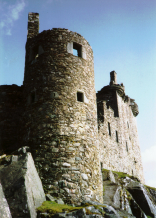Maggie Wall and Kate MacNiven
text from Scotland's Wicked Witches
Two intriguing cases come from Perthshire, intriguing because, although they are both well and widely known, there is no corroborating or contemporary written evidence to support either.
Maggie Wall
The first is Maggie Wall. There is a monument to her on the B8062 road between Auchterarder and Dunning, about 0.5 miles from the latter village. The monument consists of a stepped plinth surmounted by a pillar and is topped by a small cross. Written in white is: ‘Maggie Wall burnt here 1657 as a witch’.
So, who was Maggie Wall?
Although Dunning was not immune from witchcraft accusations, there are no records of a Margaret or Maggie Wall, Walls or Wallace, so the name, at least, may be apocryphal and the monument may be a memorial used to represent those who were executed than any one particular person.
The writing is regularly repainted and flowers and other items are left at the monument. Maggie is said to be the last victim of the witchcraft accusations to be burnt alive, although – as noted elsewhere – it was usual to throttle the victim first.
It is possible to visit the monument, although parking on the road is limited. Coins and other items, including candles, are left at the monument.
Kate MacNiven
Another well-known story is that of Kate MacNiven, also known as the Witch of Monzie.
So, who was Kate?
Kate was reputedly a nurse at Monzie Castle, which lies a couple of miles north and east of Crieff, also in Perthshire, and she attained a reputation as a witch, who – among other things – could turn herself into a bee.
Kate was seized, taken up a hill known as the Knock of Crieff to the north of the town, and was then rolled down the steep slope in a barrel. The slope down which was pushed is now called Kate McNiven’s Craig.
She was then burnt at a place near an ancient five-foot standing stone (now known as Kate MacNiven’s Stone), which is located to the south of the drive to that goes to Monzie Castle.
One of the Grahams of Inchbrackie (which is a neighbouring property) tried to save Kate, but to no avail. In thanks, she spat out a bead into Graham’s hand. The bead turned out to be a sapphire, which was used as the stone in a ring, and she told Graham that as long as his family kept the bead they would prosper (in truth, they may have but Inchbrackie Castle has gone and the lands were sold in 1882).
She also cursed the laird of Monzie and his family, another branch of the Grahams, did lose the property. Monzie Castle survives and is still a family home, although not of the Grahams.
Again it is not clear whether Kate MacNiven was a real person or a conflation of witchcraft stories.
There are no contemporary written records for her, and the date of her unpleasant death is given variously as 1563, 1615 or 1715. MacNiven or NicNiven was also the name given to the Queen of the Fairies or of Elfame.
Whatever the truth of it, Kate MacNiven’s name now appears on the Ordnance Survey map of the area.
© Martin Coventry 2017








